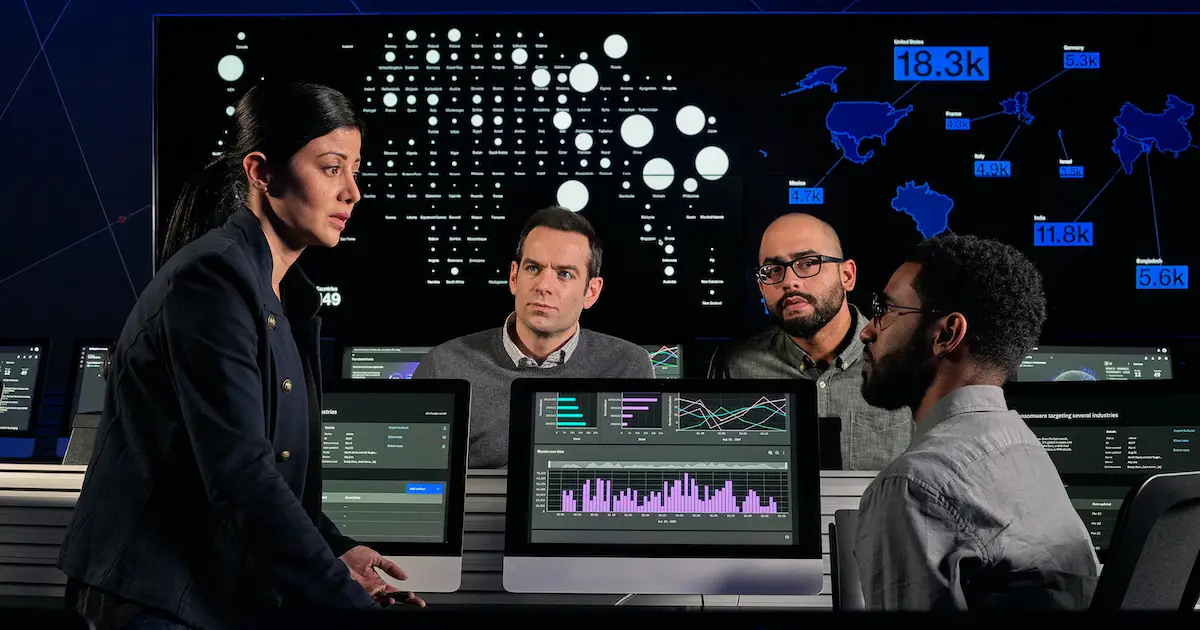During the past six months, IBM X-Force has been seeing an unprecedented increase in requests to build cyber ranges. By cyber ranges, we mean facilities or online spaces that enable team training and exercises of cyberattack responses. Companies understand the need to drill their plans based on real-world conditions and using real tools, attacks and procedures.
What’s driving this increased demand? We suspect the all-remote work situation due to the COVID-19 pandemic has elevated the priority to collaborate and train together as a team with the goal of being prepared for potential incidents.
Another force driving demand for cyber ranges is the rapid growth of high-profile attacks with seven-figure loss events and the public disclosure of attacks, impacting reputation and financial results. Damaging attacks, like data breaches and ransomware, have cemented the criticality of effective incident response to prevent worst-case outcomes and rapidly contain eventual ones.
Once you decide that your cybersecurity team and other actors in your cyberattack response protocols need to practice together, the economics for a dedicated cyber range is compelling. An organization can train many more employees more quickly through a dedicated cyber range.
But before you pull the trigger and order a cyber range, you should make a full evaluation of the pros and cons. The primary con, of course, is that a dedicated cyber range might be oversized for the organization’s long-term needs. You might not use it enough to justify the costs of building and operating an actual range. Alternatively, you might prefer to run cyberattack exercises remotely to more closely simulate the real work environment of your teams.
This post will provide a primer on conducting a graduated cyber range evaluation and help set up processes to think through what type of drilling grounds might be best suited for your team.
Why Build a Cyber Range? Mandatory Training, Certifications and Compliance
The most compelling reason for building a cyber range is that it is one of the best ways to improve the coordination and experience level of your team. Experience and practice enhance teamwork and provide the necessary background for smart decision-making during a real cyberattack. Cyber ranges are one of the best ways to run real attack scenarios and immerse the team in a live response exercise.
An additional reason to have access to a cyber range is that many compliance certifications and insurance policies cite mandatory cyber training of various degrees. These are driven by mandates and compliance standards established by the National Institute of Standards and Technology and the International Organization for Standardization (ISO). With these requirements in place, organizations are compelled to free up budgets for relevant cyber training.
There are different ways to fulfill these training requirements. Per their role in the company, employees can be required to undergo certifications by organizations such as the SANS Institute. Training mandates can also be fulfilled by micro-certifications and online coursework using remote learning and certification platforms, such as Coursera. The decision to avail a company of a cyber range does not always mean building one in-house.Learn more
A Cyber Training Progression in Stages: From Self-Study to Fully Operational Cyber Ranges
In talking with our customers, we offer them multiple options for cyber range setups, and we advise them to carry out the implementation in stages. Each stage is appropriate for a different level of commitment, activity and desire for a fully immersive cyber range experience.
Stage 1: Self-Training, Certifications and Labs
Stage 1 is blocking and tackling, the bare minimum for competent cybersecurity training. This provides the basics required for continuing education and fulfilling cyber training requirements. Stage 1 can include:
- SANS training course in desired areas of expertise
- Completion of Coursera online self-paced or Massive Open Online Course classes with requisite certification of completion
- Specific class focus, such as reverse engineering malware or network forensics to explain how attackers traverse networks without being detected, etc.
An added part to Stage 1 is holding hands-on labs where participants complete tasks or simulate blue team or red team activities. The labs should focus on outcomes and metrics as much as they focus on completion. Participants should understand whether they are able to efficiently and effectively find indicators of compromise and mitigate attacks, as well as map the primary tactics, techniques and procedures (TTPs) associated with those attack simulations.
Stage 2: Team and Wider-Scale Corporate Exercises
In Stage 2, the more mature companies can escalate to coordinated group exercises that are planned and follow a curriculum. This requires dedicated compute infrastructure or hardware (some organizations choose to do it all from their existing workstations). In these exercises, all stakeholders take the lessons they have learned and bring them together to orchestrate a coordinated response. You may choose to have red teams attempt to infiltrate and go up against blue teams and involve threat intelligence teams and other security staff in the company’s security operations center.
If you want to make this stage a more immersive and realistic experience, you may also choose to include other teams, such as marketing. Bringing in operational technology (OT) teams at this stage is strongly suggested. Many of the most recent ransomware attacks have targeted not just laptops and other IT devices but also OT devices.
Business leaders tend to benefit strongly from witnessing and experiencing immersive coordinated exercises. Giving them insights into what other teams are experiencing and how they need to respond provides invaluable context that comes into play during an actual crisis. The most advanced team cyber response exercises can involve dozens or hundreds of team members and last several days.
Stage 3: The Collaborative Cyber Range With Vendors, Customers and Partners
Coordinating responses for your organization is a great start. But what about those around you — your customers, vendors and partners? The nature of your digital infrastructure, the ubiquitous connection to application programming interfaces, the proliferation of connected devices and the varying types of connections make it critical to coordinate an attack response with your closest third parties.
It’s easy to understand the criticality of an orchestrated response. The world has become more and more connected; the digital links among vendors, customers and partners have grown. An organization can have hundreds of third-party connections at a time. This has increased the attack surface and made supply chain attacks a preferred tactic with cyber criminals and nation-state actors alike. Supply chain attacks can be hard to detect because they come through a trusted intermediary. They are also a general-purpose exploit for securing future access, traversing networks and expanding horizontally inside an organization.
With awareness of third-party risk management, software supply chain risk growing and attacks in this realm more complex than ever, we are seeing customers asking to take their cyber readiness and exercises to the ecosystem level.
More than a concept to eventually consider, we actually see some companies demanding this participation as a condition of a partnership or becoming a key vendor. Chief information security officers (CISOs) and risk teams want to see beyond the attestations of SOC2 or ISO 2700 and test out the actual capabilities and readiness of their core partners and vendors.
For example, if an organization uses a bank that employs a payment processor that subsequently uses a clearinghouse, all three are tightly knit and have likely established some playbooks on how to work together, how to identify where the chain of interactions encounters a problem or when a breach has occurred. Ultimately, they should know how to contain and stop a cyberattack involving one or more of the three entities. Proactively establishing a risk-aware working relationship and identifying and introducing specific risks for each stakeholder can facilitate a more robust, comprehensive and rapid response in case of an attack. Often this is the point of bringing several parties into the collaborative exercise: to set up the procedures and norms for a collaborative response that’s agile and precise.
Keeping Your Training and Range Lively With Fresh Content and Context
A key part of why we believe organizations are seeking to build their own cyber ranges is the rapid acceleration of attack types and the extent of attacks. Threats that used to emerge over the course of months now emerge in weeks or days. CISOs and risk management leaders recognize this and understand that there are two key ways to address this shift:
- Increase the frequency of exercises
- Improve the content of exercises to keep things fresh over time
With cyber ranges, we can use both static, curriculum-driven content for stage 1 exercises and push evolving content with industry context for those moving to more elaborate exercises. We typically insert lessons and exercises based on attacks that may be happening concurrently with the exercise itself. We use SafeBreach to inject information about recent and ongoing attacks that are contextually relevant to the industry and the customers.
Because SafeBreach has a 24-hour service-level agreement in terms of adding new attacks and control validations, even attacks only seen in the wild a few days prior can be tested. This capability is why we recently changed the design of our ranges to enable customizable content that can be modified on the fly. This allows a company with a cyber range to load up an exercise on a major attack days after the attack is revealed. That capability makes cyber ranges more relevant and valuable because it enables organizations to speed up their security metabolism and learn faster. The SafeBreach continuous risk assessment and security control validation platform includes the world’s largest compendium of attack playbooks with accurate TTPs for each attack.
Conclusion: Are You Ready for a Dedicated Cyber Range?
Before you get to the point of thinking about a dedicated cyber range, we highly recommend you work through stage 1 and stage 2 capabilities. At a minimum, you should run a cyber range exercise as a one-off to see how it works for your team and your organization. Most crucially, consider what the utilization rate of your cyber range will be when planning. Ideally, it should be in use most of the time to maximize your investment. Think through whether this is viable for your team and your enterprise before pulling the trigger. As a mitigating factor, think through whether you can use your dedicated cyber range as a pop-up or quick-start cyber operations command center in case of emergency.
After you feel comfortable with the idea of a cyber range and have confirmed its value, consider the positives and negatives of the three types of cyber ranges or outsourcing exercises to a trusted vendor.
- Dedicated on-premise ranges are more expensive to build and maintain but can help teams create in-person chemistry. As the COVID risk recedes, this is becoming a more viable option.
- Creating an entirely virtual cyber range prior to the pandemic was not something many organizations were considering. Virtual versions are cheaper to stand up and upgrade and offer more flexibility. However, for some organizations, face-to-face interactions are important.
- A number of customers have come to us requesting hybrid versions with both virtual and in-person components. Hybrid models are flexible and can extend to vendors and partners but are also the more expensive installations.
Having a cyber range at the ready is a fabulous foundation for upping your security metabolism and readiness. Follow a rigorous decision-making process to ensure you get the right kind for your organization and needs. To learn more about how IBM Security can help your organization plan its response strategy and map ways to help your teams drill cyber response, visit the Command Center site here.


